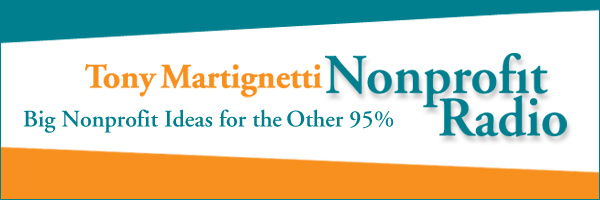I’ll be on the first Nonprofit Radio program of 2016 on Friday, January 8, at 10:30 am PT / 1:30 pm ET discussing the IRA Charitable Rollover with host Tony Martignetti. Catch us live on Talking Alternative or a few days later on iTunes.
Legislation
Until the PATH Act was signed into law at the end of 2015, the last day an individual could make a qualified charitable donation from an IRA was December 31, 2014. The PATH Act permanently extended this charitable giving incentive, which was first temporarily established under the Pension Protection Act of 2006 and renewed annually thereafter through the end of 2014. By making the incentive, among certain other temporary breaks (tax extenders), permanent, Congress must now factor it into the budget and stop using it as a point of political negotiation.
What is the IRA Charitable Rollover?
The IRA Charitable Rollover provision allows individuals aged 70½ and older to donate up to $100,000 from their traditional or Roth IRAs to eligible public charities without having to count such qualified charitable distributions as taxable income. Distributions from traditional IRAs, which are required starting at age 70½, are otherwise typically included in the individual’s adjusted gross income (AGI) and subject to income tax.
Because the qualified charitable distributions aren’t counted in an individual’s AGI, the individual cannot claim an itemized charitable deduction for them. But the IRA Charitable Rollover, unlike the charitable contribution deduction, is available to taxpayers, regardless of whether they itemize their deductions.
A Tax-Efficient Way of Giving
If a taxpayer wants to make a charitable contribution and can do it through a donation of cash or through the IRA Charitable Rollover, it will be advantageous to do it through the IRA Charitable Rollover.
- A charitable contribution deduction is only available to taxpayers that itemizes their deductions; the IRA Charitable Rollover is available to taxpayers regardless of whether they itemize their deductions.
- The charitable contribution deduction is subject to certain limitations based on the taxpayer’s AGI; the IRA Charitable Rollover is not.
- The IRA Charitable Rollover counts as part of a taxpayer’s minimum required distributions and doesn’t increase the taxpayer’s taxable income or AGI (which has other benefits, including more favorable tax treatment of Social Security benefits and lower Medicare Part B & C premiums).
- In certain states, it is not possible to take a charitable contribution deduction for state income tax purposes, but states generally adopt the federal definition of gross income.
Senate Finance Committee Working Group Report (July 7, 2015)
“The now-expired rules allowing taxpayers to exclude qualified charitable distributions from gross income have the salutary effects of encouraging and facilitating charitable giving. The rules accomplish this by allowing an IRA owner to arrange for a distribution to be made directly from his or her IRA to a qualified charity and generally to exclude the amount of the distribution from the IRA owner’s gross income. As a result, a taxpayer who has accumulated more assets in an IRA than she will need to fund her retirement expenses need not arrange both for a distribution from the IRA to the IRA owner and a subsequent donation to charity.
The intended benefits of the provision may be diminished by extending the provision only on a temporary basis, particularly where the provision is enacted late in the year to which it applies. When the provision was last extended in December 2014 for calendar year 2014, for example, many IRA owners who otherwise might have benefited from the provision were not able to use it. Some taxpayers were unable to arrange an IRA distribution, because their financial institutions’ deadlines for requesting distributions for the 2014 calendar year already had passed. Others took required minimum distributions from their IRAs before the extension was enacted and were no longer in a position to arrange for further distributions. While the Working Group does not make specific recommendations, the Committee may wish to consider proposals for qualified charitable distribution rules that would increase certainty for taxpayers and increase the amount of funds that flow to charity.
While the exclusion for qualified charitable distributions provides a critical incentive for charitable giving, the Working Group is mindful of the importance of ensuring income security for retirees. Some might argue that the exclusion for qualified charitable distributions encourages IRA owners to redirect retirement savings to a non-retirement income security use (charitable giving) before they know the full extent of their income needs during retirement. Others, however, believe that the IRA owners most likely to take advantage of the income exclusion are well-advised taxpayers who have excess accumulations in an IRA or who would make many of the same charitable contributions even in the absence of the special exclusion.” – Read more here.
Urban Institute
“In 2008, the National Committee on Planned Giving (NCPG) conducted an informal survey asking charitable organizations to report qualified IRA distributions. Approximately 900 charities (mostly institutions of higher education) reported nearly 8,700 such distributions. Donations of less than $5,000 accounted for nearly 60 percent of all distributions, although they represented only 6 percent of the total dollar value reported. Donations in excess of $25,000 accounted for less than 20 percent of donations, but nearly 75 percent of the total dollar amount.” – Read more here.
Additional Resources (updated 3/28/16)
Popular IRS Charitable Tax Break Can Be Valuable—for Those Who Know How to Use It (Wall Street Journal, 3/27/16)

You must be logged in to post a comment.